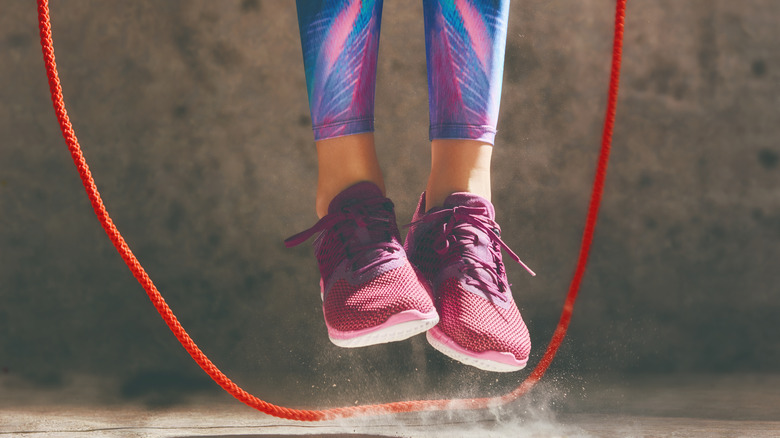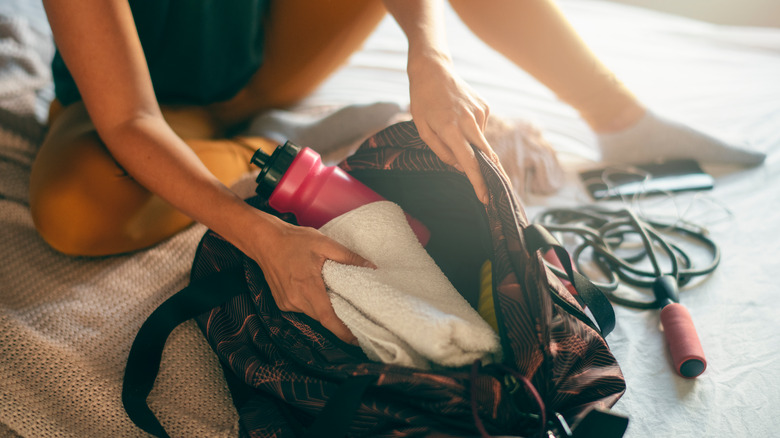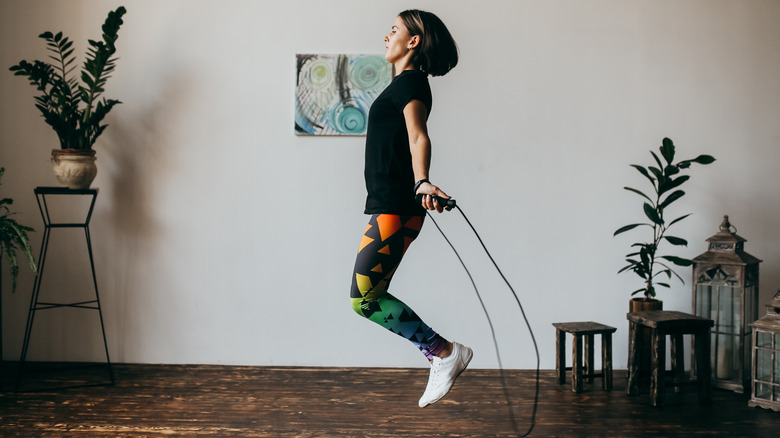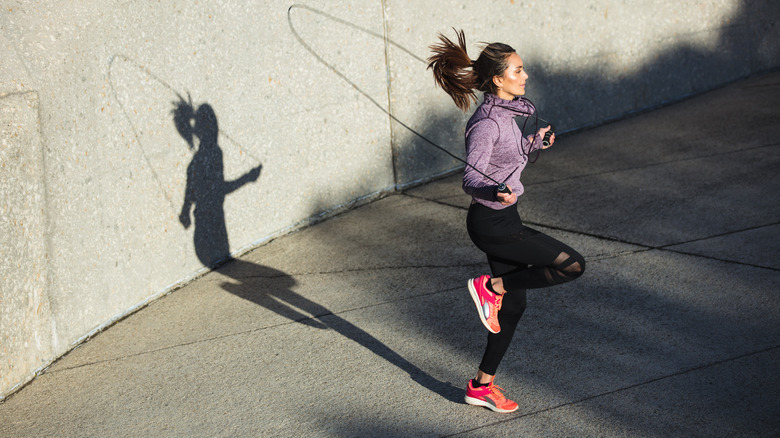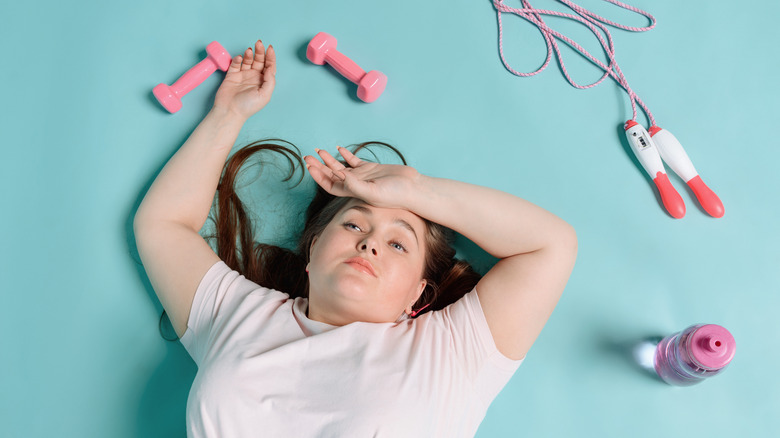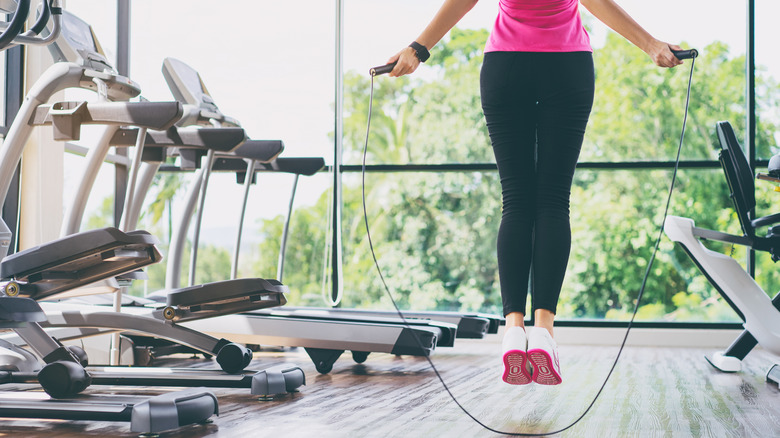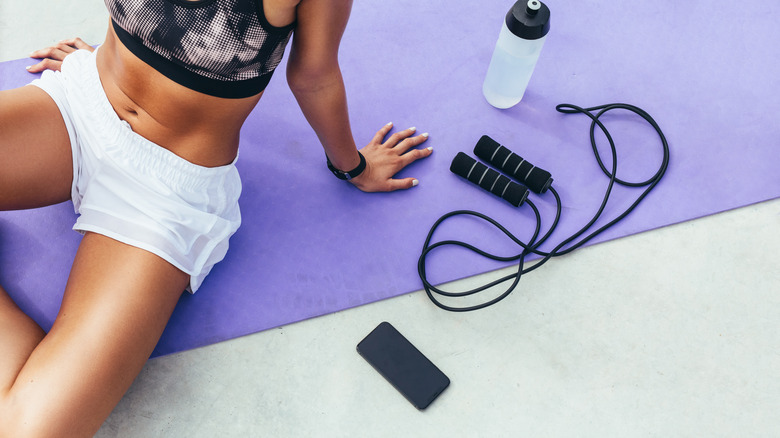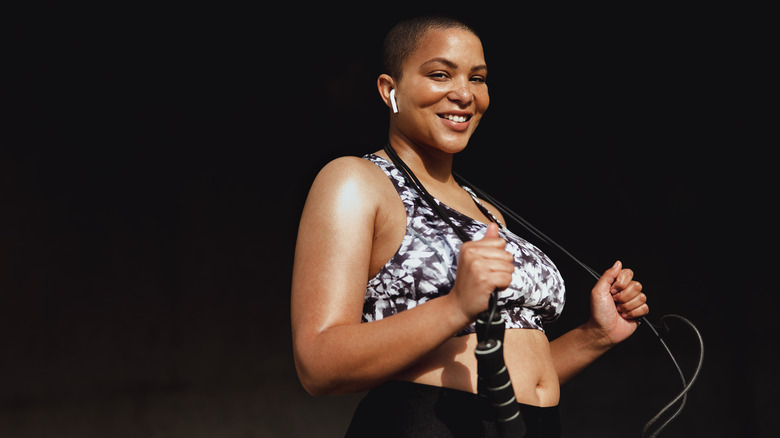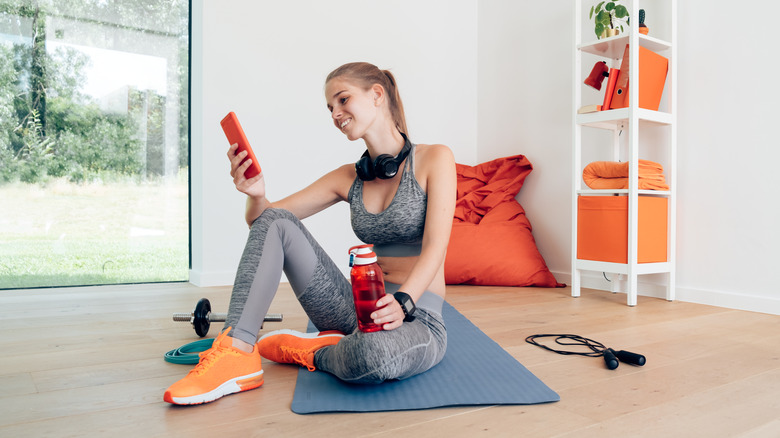What Happens To Your Body When You Jump Rope Every Day
If you're looking for a low-maintenance piece of exercise equipment and a fun, portable workout option, consider the jump rope. You may have childhood memories of jumping rope, but perhaps in adulthood, you forgot what a powerful little piece of equipment a jump rope can be. Jumping rope can keep you young at heart by reducing the effects of aging.
A jump rope offers access to a challenging exercise when you are homebound or traveling and don't have access to a gym or safe walking or running path. It's easy to find a jump rope for under $5, and you can use a jump rope just about anywhere you have the floor space and height to swing the rope. If you're low on space or budget, you can mimic the movements without a rope!
It's a skill that's relatively easy to master with some practice. Jumping rope requires basic timing, coordination, endurance, and strength to accomplish a few minutes of consistent jumping, and these skills can be improved over time to achieve longer sessions. If you commit to jumping rope every day, the exercise can truly transform your body. Fighting the effects of aging is only one of many reasons to start a jump rope routine. Let's take a look at other ways your body can change when you jump rope every day.
Jumping rope will improve foot function and mobility
Every day, we use a system of bones, ligaments, tendons, and muscles in our feet to get where we need to be. A decline in foot health and function can lead to a loss in quality of life, as noted by a study published in Scientific Reports. Fortunately, jumping rope is an excellent way to challenge your feet to improve foot strength and mobility. The action of jumping rope demands quick rebounding with the feet and helps the feet gain strength.
Our arches absorb shock and provide balance and stability as we move. Arch stiffness can cause foot pain and a decline in our balance and stability (via Healthline). Reactive strength is all about your body's ability to react to a change in your footing, such as when you are walking on uneven terrain or experiencing an unexpected obstacle in your path. Improved reactive strength can help to reduce injury risk and can reduce fall risk as we age.
In one jump rope study published in the International Journal of Sports Physiology and Performance, the researchers asked runners to jump rope two to four times per week for a total of 10-20 minutes per week for 10 weeks in place of their normal five-minute pre-exercise warm-up. After 10 weeks, the jump rope group experienced gains in jumping ability and reactive strength in the feet, and they had decreased arch stiffness.
It's encouraging news that you can improve your overall foot health by adding as little as 10 to 20 minutes of jump rope each week!
Your lower limb strength and power will increase
Muscular strength is measured by the body's ability to apply force, while muscular power is measured by the body's ability to apply force over a faster amount of time, as noted by Human Kinetics. Strength and power are necessary for ease of movement and to decrease injury risk as we age. Jumping rope every day is a great way to improve muscular strength and power in your lower body. The quadriceps, glutes, calves, abdominals, hip flexors, and foot muscles are used when jumping rope and these muscles will gain strength and power when you jump rope every day.
In 2018, researchers tested leg strength in 10 to 12-year-old boys after adding 10 weeks of jump rope training three times per week, as shared in the Universal Journal of Educational Research. Following the jump rope program, the researchers found that leg strength had significantly improved for the boys. The researchers strongly recommended a jump rope program to improve leg strength. Another study published in High Technology Letters tested a jump rope routine on trained volleyball players. Despite these athletes already possessing above-average strength and power, the jump rope program helped the athletes gain significant leg strength and power when they added jump rope to their workouts for eight weeks.
Even if you are already a trained athlete, adding a daily jump rope habit to your routine can still help you make gains to your lower leg strength and power.
Jumping rope can increase coordination and balance
Someone who is coordinated gives the outward appearance of moving smoothly with grace and balance. Within the body, a network of nerve, brain, and muscular functions are at work to choose the appropriate muscles to work at the right time and intensity. Coordination of movement is developed over time through neurological adaptations. These adaptations help us to feel stronger and more confident in our movement as we stay consistent with an exercise program.
Coordination and balance combine to help us be aware of our body in its surroundings and move with ease. Coordination and balance are also important to limit fall and injury risk at any age.
Jumping rope every day can lead to neurological improvements that improve coordination and balance. A study published in 2015 in the Journal of Sports Science & Medicine showed that athletes who began their workout with jumping rope had better general motor coordination after eight weeks than the control group who went through their daily workouts without jumping rope.
It can boost your respiratory and cardiovascular fitness
Jump rope is one of the most accessible ways to get a great cardiovascular workout. Taking care of your heart and lungs is important for long-term health. Heart disease is the No. 1 cause of mortality, and about one in four individuals die from heart disease (via CDC).
In 2017, researchers at a Korean university, who published a study in the Journal of Physical Therapy Science, recruited a group of women in their 20s who were classified as overweight and had them jump rope to music three times a week for four weeks. They found that vital capacity, a measurement of the volume of air that is expelled after taking the deepest possible breath, increased significantly for the jump rope group.
Researchers at San Beda University in the Philippines asked a group of 70 males and females to participate in a multi-stage jump rope program for eight weeks and found that VO2 max, a measurement of the maximum amount of oxygen that can be used by an individual during exercise, increased for all participants, as their study published in International Journal of Human Movement Science noted.
If you use the jump rope for a high-intensity (HIIT) workout, you can make cardiovascular improvements at a faster rate and to a greater degree (via VeryWell Fit). HIIT workouts involve higher intensities during shorter sets that are often timed.
Jumping rope enhances muscular endurance
Muscular endurance is important for necessary functions, such as posture and activities of daily living. When we have good muscular endurance, we can complete tasks or exercises for much longer without getting tired. Muscular endurance can be useful even if you are not an endurance athlete. Household tasks like painting a room or yard work can be performed with greater ease if you have good muscular endurance.
Overly tired muscles can also lead to a greater risk of injury, as noted by a study published in Physical Medicine and Rehabilitation Clinics of North America. Muscular fatigue is a process that is governed by the muscles, brain, and nerves, and exercises that require the body to perform for a sustained period of time can train this network to withstand fatigue.
In 2019, researchers set out to test the effects of a 12-week circuit training program on 60 school-aged girls, according to a study published in the Indian Journal of Public Health Research and Development. They included two additional groups that added resistance bands and jump rope, respectively, to the circuit training. The groups that added resistance bands and jump rope to the circuit training saw greater improvements to muscular endurance.
Jumping rope every day can help with body weight management
Fitness professionals have begun to move away from preaching the idea that exercise is the best way to manage body weight. The problem with using only exercise to manage body weight is that it takes an enormous amount of effort and time to burn enough calories to lose body weight when compared to how easily calories can be controlled through diet and portion control. Instead, exercise contributes to overall health and it can serve as an excellent aide to weight management. Jumping rope is a great way to contribute to the 10 to 20% calorie deficit that is needed to drop or maintain body weight (via Healthline).
In 2018, researchers published a study in the European Journal of Applied Physiology that showed that a 12-week jump rope training program was successful in significantly reducing belly fat. In another study published in the Journal of Physical Therapy Science, researchers compared a jump rope routine to stationary cycling and found that the body mass index was lower for the jump rope group.
If you are trying to lose body weight, try a combination of calorie control through your diet, and jump rope every day to boost the calorie deficit that is needed to shed the pounds.
You'll develop your core strength and endurance
Core strength is literally at the center of nearly all movement. When you have a strong core, your pelvis, lower back, hips, and abdominal muscles are all working together to achieve healthy movement and keep your body protected from injury. When you jump rope every day, your core is being used to stabilize your pelvis and lower back as you complete the repetitive jumping motion.
Researchers at the School of Sport and Exercise Science in New Zealand added a jump rope regimen to the training of a football team. The athletes in the jump rope group completed five sets of one minute of jumping rope two times per week. At the end of the six-week program, the jump rope group could perform significantly more sit-ups than the group who had completed the football training alone. Interestingly, the core strength outcomes showed greater improvement when compared to the upper body strength outcomes that were also measured in the study.
Your shoulders will become stronger and more stable
We need our shoulders to be strong and flexible so we can achieve simple daily tasks. Motions that involve raising your arm above your head, such as dressing yourself or reaching for a grocery item on the top shelf, are activities that can be taken for granted until they become difficult to perform. Jumping rope is typically viewed as a lower-body strengthening exercise, but the shoulders are important when jumping rope. The shoulder muscles help start the rope and continue the swinging motion, as well as stabilize the rope as it swings.
In a study published by the Journal of Sport Rehabilitation, researchers tested the rotational strength of the shoulders of 24 young volleyball players following a 12-week jump rope intervention. Some participants used weighted ropes while others used non-weighted ropes, but both groups experienced significant improvements to rotational strength of the shoulders after the jump rope program.
If you're new to jumping rope, you can skip the weighted rope for now. You can start with a non-weighted rope and still make great gains. You can always switch to a weighted rope when you are ready for the next challenge.
Jumping rope can help strengthen your pelvic floor muscles
The pelvic floor muscles are responsible for the action of stopping urine flow, and they also play a vital role in sexual health and satisfaction. Physicians and physical therapists often encourage isolated exercises, such as Kegels, to increase the strength of the muscles that support the bladder and bowels. Dynamic exercises, like jumping rope, can also help to strengthen the pelvic floor muscles, as noted by a study published in International Urogynecology Journal. The action of continuous jumping creates reflex activity in the pelvic floor muscles that help to strengthen them over time.
At the beginning of a daily jump rope program, you may feel bladder leakage if you have weak pelvic floor muscles. The key to preventing bladder leakage and strengthening the pelvic floor is to keep the core engaged while you are jumping rope (via The Healthy), and you should keep your abdominal and back muscles firm and engaged while using the jump rope.
If you have weak pelvic floor muscles due to childbirth or aging, a daily jump rope program can help you regain pelvic floor health over time if the exercise is performed correctly.
Jumping rope increases bone density
Having healthy bones can help us maintain a high quality of life as we age. Our bones stop producing new mass around age 30, and it becomes necessary to ensure you are getting enough calcium in your diet and to preserve bone health through exercise. Bone density measures the health of the bones and it is directly related to injury risk and mortality as we get older.
You may have heard the term "load the bones," which refers to performing weight-bearing exercises. Our bones need a healthy and normal amount of stress put on them to help retain their strength. Weight-bearing exercises include walking, running, stair climbing, dancing, and jumping rope. It's especially important to focus on bone health if you like to do non-weight-bearing exercises for cardiovascular health, such as swimming or cycling.
A 2021 study published in the Journal of Bone and Mineral Metabolism showed that 20 minutes of jump rope training twice a week for 22 weeks significantly improved bone mineral density in the lumbar spine of 16 swimmers. Sounds promising!
Your confidence and self-image will get a boost
Physical activity of any kind is a great mood elevator and can have positive long-term effects on mental health by improving self-esteem and cognitive function, according to an article in Primary Care Companion to the Journal of Clinical Psychiatry. People who exercise consistently can achieve lessened symptoms of depression and anxiety and experience improvements to confidence, self-image, and self-efficacy.
Acquiring a new skill and making improvements to that skill can help you feel connected to others and can boost self-esteem (via NHS). As you start a jump rope program, you may feel clumsy or less than graceful, but with consistent daily work, you will prove to yourself that you can get better at a new skill. As shared in a study published in Perceptual and Motor Skills, researchers guided 11 9 to 11-year-olds through an eight-week jump rope program and found that the children had significantly improved self-concept.
What is noteworthy about this study is that these children already had above-average levels of self-concept before the jump rope program. So, even if you are already a confident person with a solid concept of yourself, you may still see improvements to your mental health when you jump rope every day.
Jumping rope could potentially lead to some problems
Asking your body to perform a repetitive motion daily can also present problems, such as nagging injuries that can sometimes show up with repetitive motion. Jumping rope puts pressure on your lower leg to bear the weight of your body. When you jump, you bend at the ankle joints to load the legs and prepare for the jump, and this can create the most pressure on the front side of the lower legs. Shin splints are a common injury when this part of the leg is stressed repeatedly.
The same repetitive jumping motion can also wear on the knee and ankle joints, especially if you were already prone to injury in one of these joints from conditions such as arthritis or prior soft-tissue damage to the cartilage, tendons, and ligaments. If you experience any pain from jumping rope, take a few days to rest and consult your physician about any concerns.
Some people who jump rope complain of urinary incontinence (via International Urogynecology Journal). Although jumping rope has been shown to improve the pelvic floor, it can still be bothersome to experience bladder leakage each time you try to jump rope, and it can keep you from wanting to try the exercise. If this is a problem for you, talk to your doctor or physical therapist for helpful tips to strengthen your pelvic floor.
